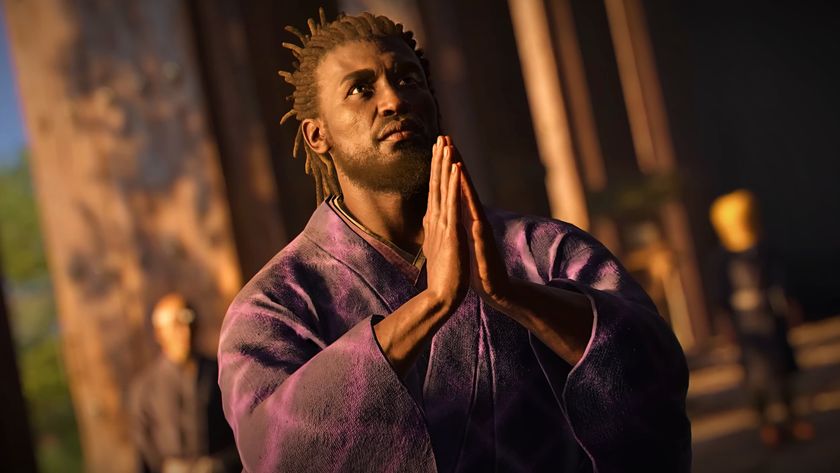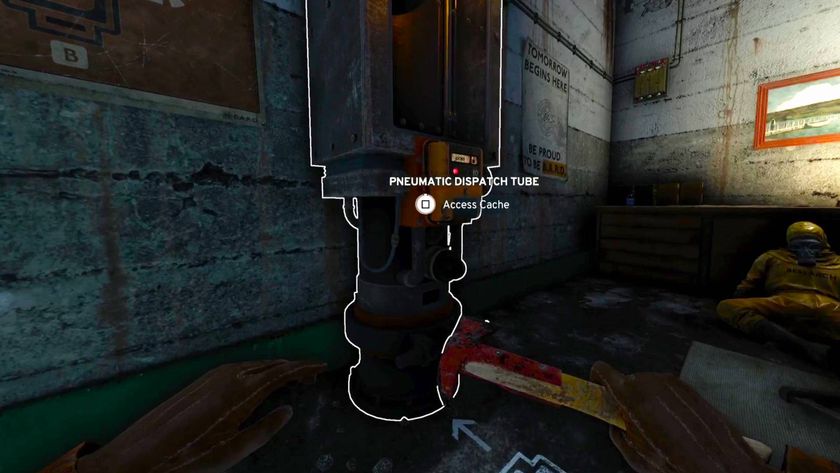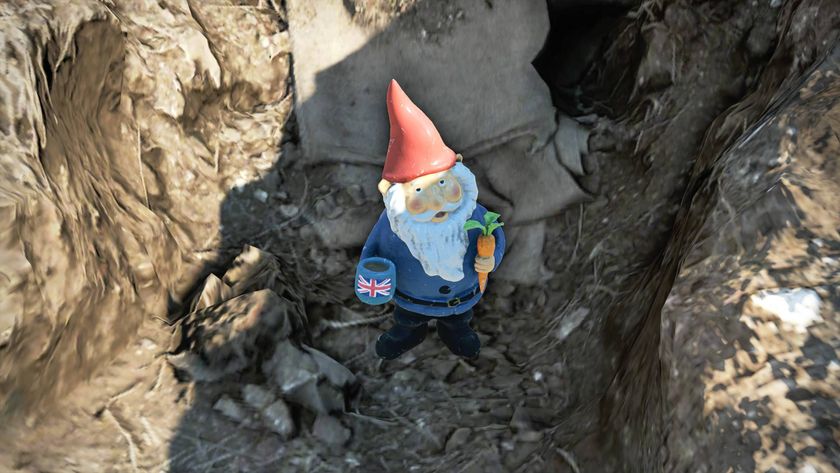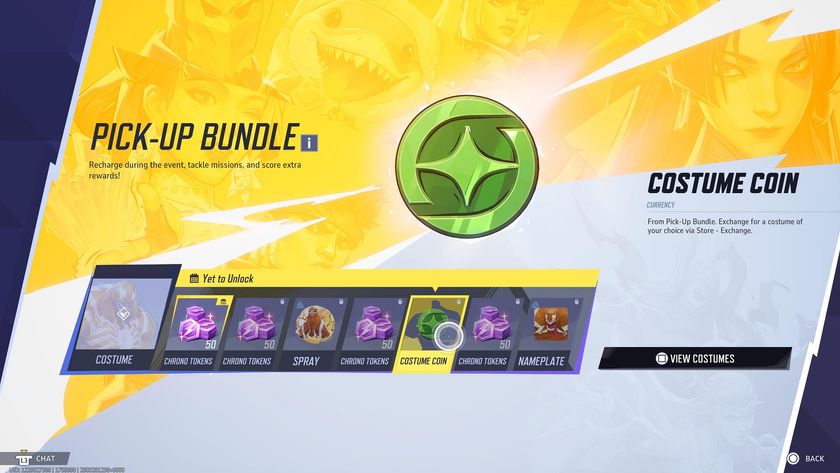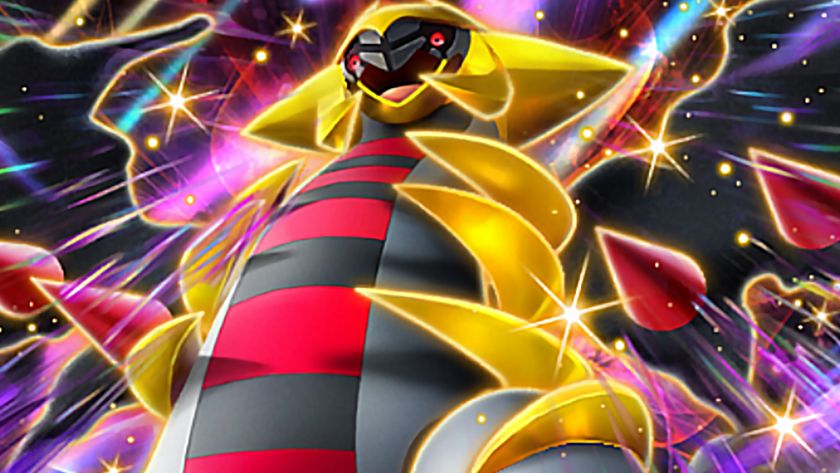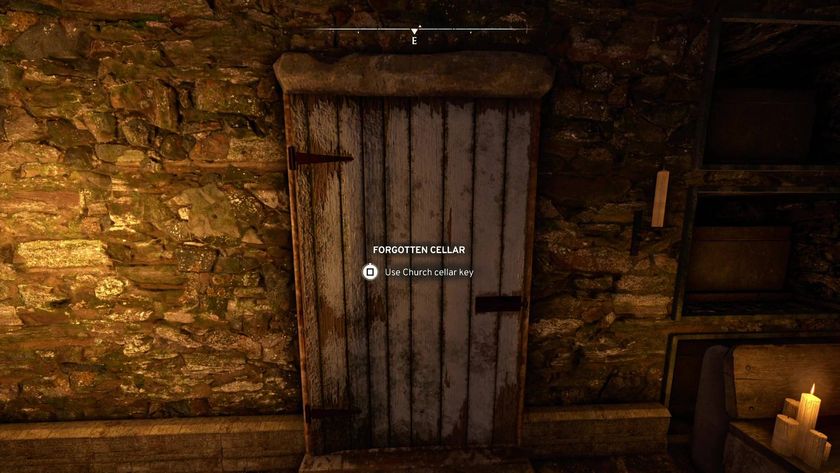Soulcalibur 4 Mitsurugi character guide
-------------------------------------------
MITSURUGI, CHARACTER GUIDE - SOUL CALIBUR 4
Version 1.12
-------------------------------------------
CONTENTS
#1.0 PURPOSE AND INTRODUCTION
#1.1 Who this guide is for
#1.2 Who this guide is not for
#1.3 Notes
#1.4 Using the search function
#2.0 THE BASICS
#2.1 Story
#2.2 Character description
#2.3 Strengths and weaknesses
#2.4 Notation and jargon used in this guide
#2.4A Controls
#2.4B General jargon
#2.4C Move information and properties
#2.4D Mitsurugi's stances
#3.0 LEARNING TO PLAY WITH MITSURUGI
#3.1 General Strategy
#3.2 Moves to learn first (my movelists)
#3.2A Movelist A: Primary attacks
#3.2B Movelist B: Secondary attacks
#3.2C Movelist C: Relic stance
#3.2D Movelist D: Mist stance
#3.2E Movelist E: Situational attacks
#3.2F Movelist F: Other ways to get into and between stances
#4.0 COMPLETE MOVE LIST
#4.0A Reading the movelist and move properties
#4.1 Normal stance
#4.1A Normal stance to relic stance
#4.1B Normal stance to mist stance
#4.2 Relic stance
#4.2A Relic stance to mist stance
#4.2B Relic stance to normal stance
#4.3 Mist stance
#4.3A Mist stance to relic stance
#4.3B Mist stance to normal stance
#5.0 CREDITS, INFORMATION AND VERSION HISTORY
*******************************************************************************
-----------------------------
#1.0 PURPOSE AND INTRODUCTION
-----------------------------
#1.1 Who this guide is for:
-People who want to start playing Mitsurugi or want some information about him
to help fight against him.
-People looking for some strategy hints on how to play Mitsurugi.
-People who want an organised list of Mitsurugi's moves, including getting into
and between his stances, with information on damage, hit ranges,
horizontal/vertical information, properties, range and speed.
-People who would like to learn Mitsurugi's moves and want some guidance as
to which ones to start with, and which ones to progress to later.
#1.2 Who this guide is not for:
-People who have just got hold of Soul Calibur 4 and have not played any
previous SC games or got to grips with the basics. If this is the case, please
either read the instruction manual or another comprehensive FAQ, have a good
play around with the game, and return when you have a handle on how the game
works.
-Advanced Mitsurugi players who are looking for high level strategies. I am a
competent player having used him since SC2, but I'm not an expert. Sorry!
You are welcome to look through my recommended movelists with commentary, maybe
there will be a little something you hadn't thought of!
-People who want a frame data. I have described how quick the moves are
generally, but not anything precise. You can find a lot of this
information at www.caliburforum.com in the soul arena section of the forum.
-People who want details about all of Mitsurugi's equipment, weapons stats and
such. All this information is can be found in other FAQs:
Equipment http://www.gamefaqs.com/console/xbox360/file/940048/53716
Weapons http://www.gamefaqs.com/console/xbox360/file/940048/53656
#1.3 Notes:
-This guide was made using the Xbox 360 version, but it should apply to the PS3
version as I believe they are pretty much identical.
-To compress the complete movelist, I have grouped similarly inputted moves
together as alternate inputs.
-I present the complete movelist from the game into more logical groupings, and
show you the moves I recommend in smaller movelists, and in which order
to learn them.
-I guess people must have thought his 'moon' moves were too powerful, as they
have mostly been taken out, leaving him with just one windup and one move from
it, although he regains his former superpower move that used to be [6] B B
in earlier games, but it can now only be done from his mist stance as 6+B B.
-B K B from mist stance is not in the game's movelist, credit to my brother for
finding that combo!
-Make sure you read the notation and jargon section and the how to read the
complete movelist section before you before jumping into the complete movelist,
or you will be unlikely to make sense of most of it!
#1.4 Using the search function
If you want to jump to a particular section in this guide, this is the
quickest way to do so:
-Find the reference of the section you wish to jump to in the contents, for
example #6.3D
-Put the cursor at the very top of this guide
-Hold Ctrl and press F, and where it says 'Find what' or 'Find' type in the
reference number (if using Firefox instead of Internet Explorer, the 'find' tab
may appear at the bottom left of your screen)
-Check that direction is set to down, then click the 'find next' button twice
(click the 'next' button twice if using Firefox)
-You should now be at the section you want to find
---------------
#2.0 THE BASICS
---------------
#2.1 Story (my interpretation): Mitsurugi is a wandering warrior, who is
always looking for his next combat challenge. He has yet to be beaten, and
grows tired of easily striking down all who oppose him. The call of the
powerful sword gives him hope that he may yet meet a worthy opponent.
#2.2 Character description: Mitsurugi plays much like any other character, with
the addition of two other fighting stances from which he has many attacking
options. He uses a medium length sword and can be a highly aggressive and
intimidating character. For those familiar with Tekken, there are some notable
similarities between Mitsurugi and Paul Pheonix. Both are wandering fighters
who have never been beaten, both use a highly explosive and aggressive style,
Mitsurugi's 2+K B is pretty much the same as Paul's 2+RK RP, and they both
never lose in the tournaments but somehow end up not the credited victor for
strange reasons beyond their control. They also both seem to be 'in house
favourites', as they get seemingly hugely powerful easy to use moves which can
crush opponents, but they are kept behind the scenes and out of the main
storylines. That is just my opinion, but look who you always face in
practice mode...
#2.3 Strengths: Fast, can aggressively dominate a match, has useful stances
with many options including a range of unblockable attacks, excellent at
ringouts, high damage.
Weaknesses (or development points for the PC): Mainly small to medium range,
some lack of variety in movelist, lack of efficient low moves.
#2.4 Notation and jargon used in this guide:
#2.4A Controls
1: Down+left on the controller.
2: Down on the controller.
3: Down+right on the controller.
4: Left on the controller.
6: Right on the controller.
7: Up+left on the controller.
8: Up on the controller.
9: Up+right on the controller.
A: Press the A button (as referred to in the control scheme you have).
B: Press the B button (as referred to in the control scheme you have).
G: Press the G button (as referred to in the control scheme you have).
K: Press the K button (as referred to in the control scheme you have).
+: Simultanious button presses.
/: Indicates alternative inputs.
~: Indicates the next input must be made extremely quickly.
[x]: Indicates the input x should be held down. In the case of directional
inputs, this can also be replaced with a double tap in that direction.
(x): Indicates an additional optional input x.
{x}: Indicates the input x can be delayed.
#2.4B General jargon
AUTOPARRY: This is a purple flash that happens during certain moves, and they
parry certain types of attacks. They may knock those attacks aside, or
Mitsurugi may perform an attack animation. The details will be noted for the
individual moves.
BLOCK: See guard.
COMBO: This is a succession of attacks that form into one longer move with two
or more hits (such as A A).
GUARD: Holding down the G button while standing to block high, mid, special mid
or special low attacks; or holding down the G button while crouching to block
low, special mid or special low attacks. This stops the attack damaging you.
IMPACT (guard impact): A defensive move which deflects an incoming attack if
timed correctly.
INTERRUPT: To hit an opponent who is performing a move by doing a faster move.
PUNISH: This means to land your own attack on a helpless opponent after they
miss you with a move or are out of position.
REPEL (guard repel): A type of impact, using 6+G or 3+G to repel high/mid or
mid/low moves respectively. The player repelled cannot move, attack or block
for a short time.
SIDESTEPPING: Using the 8 way run system to try and move around your opponent's
attacks.
STANCE: One of Mitsurugi's various fighting style positions. You will become
familiar with them as you try out his attacks. The stances often link together
with various moves.
TRACKING: The ability of a move to follow the opponent as they move.
#2.4C Move information and properties
h,l,m,sl,sm (high,low,mid,special low,special mid): The parts of the opponent
an attack aims for.
*n: Indicates special property number n which will be explained below the
section of moves in which it appears (n is a number).
AT (attack throw): A move which turns into a throw animation if the hit lands
successfully and at close enough range.
CH (counterhit/counterattack) : Striking the opponent during one of their
attacks.
EC (ends in crouch): A move which will initially leave you in the crouching
position when it is complete.
EV (evasive): A move which is good at getting around, under or over other moves
giving you the chance to hit without being hit back.
GB (guard break): Indicates that a move has the guard break property. The move
has a blue lightning effect, and when guarded causes a short stun.
H (horizontal): A move that hits in a sideways motion, designed to hit
sidestepping opponents. Usually involves the A button.
HG (hits grounded opponent): A move which is able to hit an opponent who is
lying prone on the floor.
KD (knockdown): A move that knocks the opponent off their feet, giving you a
big advantage as they can't do much from that position.
LA (launching): A move which sends the opponent high into the air, usually
allowing you to use a combo on them before they land.
RO (ringout): Knocking the opponent out of the ring, winning the round
instantly. A move with this property is capable of causing a ringout, although
you and/or your opponent have to be in the correct positions for it to happen,
these vary with each move.
SP (spins): A move which causes the opponent to spin around on the spot.
ST (stun): An effect of a move which incapacitates the opponent for a short
while.
TA (taunt): A move which serves no purpose other than to infuriate or mock
the opponent.
TH (throw): Indicates that a move is a throw/grapple, a move that cannot be
blocked or impacted. It can be escaped by A or B depending on the input of the
throw. I suspect the new download 'fix' can allow throws to be impacted as a
just frame.
TR (turn round): A move that turns the opponent round.
UB (unblockable): Indicates that a move is unblockable. The move has a flame
effect and cannot be guarded or impacted.
V (vertical): A move that hits in a forward motion, designed to have priority
over horizontal moves, but that can be sidestepped. Usually involves the B
button.
WC (while crouching): Perform this move while crouching. To crouch, press 2+G,
then you can release G while holding 2.
WR (while rising): Let go of 2 while crouching.
#2.4D Mitsurugi's stances
MIST STANCE: Mitsurugi holds his sword pointing away from him ready to strike.
NORMAL STANCE: Mitsurugi stands normally as he does when the round starts.
RELIC STANCE: Mitsurugi sheathes his sword ready to strike.
------------------------------------
#3.0 LEARNING TO PLAY WITH MITSURUGI
------------------------------------
#3.1 General strategy
Use these tips while working through my movelists in the next section.
-Play aggressively. I find Mitsurugi is best when he is applying pressure,
mixing up attacks, and not letting the opponent recover enough to launch
their own attack. Do not mindlessly attack though, there are times when you
need to be a bit more defensive, you will learn this with practise.
-Mix up your attacks. Use high, mid and low moves and throws. When you think
your opponent is going to duck your throw attempt, or is expecting a low move,
instead use a fast mid move. When they are on the defensive and standing,
use a low move or a throw. Once you get to the stances, vary how and when you
use them to always keep the opponent guessing. Change to and from your stances,
and use moves to switch between them. Know what each stance can do.
-Punish opponents who stay on the floor too long to try to fool you into
attacking and missing. Mitsurugi has many attacks which hit a grounded
opponent. If they are getting up instantly instead, be ready with a quick
attack or a throw to keep your momentum.
-Try to keep close most of the time, Mitsurugi is most effective at short and
medium range. If you find yourself at distance, know which attacks can connect
from that far away, he has a few. Use the 6 6 forward step in relic and mist
stance to close in before launching an attack.
-Remember that in the mist and relic stance, Mitsurugi is generally unable
to sidestep up or down, or to guard or impact. Be careful of staying in a
stance too long and getting flanked.
-Go for ringouts. Misturugi is one of the best characters for this. Try to
force your opponent towards an edge, or move around them to line it up. Use
the moves I've indicated which ringout, varying which one you go for.
#3.2 Moves to learn first (my movelists)
I will cover which moves you should focus on when you first start to learn how
to play Mitsurugi. To help with this I have selected groups of moves from the
complete movelist, and given commentary on how to use them. Here are some hints
(skip this part if you are used to learning character moves) starting with
movelist A:
-Go into practice mode and go through all the moves in the list, get a feel
for their timing, the range they hit from, their damage and whether they hit
high, mid or low. Imagine as you do them what kind of situations they would be
useful in. Keep going through the moves until you can remember them all and
perform them as second nature.
-Start having matches using this movelist, ideally against a human opponent,
but even against the computer will help. As you use the moves in the movelist,
see when they are successful, and when they are not, and learn when best to
use them. Keep playing matches using these moves until you can recall all
the moves, having the list in front of you may help to glance at after each
match to see if you are forgetting any. Feel free to print out all of or any
part of this guide. Learn when each move is appropriate and effective, instead
of performing moves randomly. I have provided comments for each move to help
with this.
-Once you feel you have mastered the movelist, repeat this process with the
next movelist, continuing to apply all the movelists you have learnt so far.
I'd highly recommend starting with movelist A, but you can then tackle the
other 5 in whatever order you feel is best for your playing style.
I have kept each movelist quite short so it should be easy to remember them
all, and you can make steady progress. This is better in my experience than
trying to remember vast amounts of moves at once and not really knowing
how to use any of them. If you find any of the movelists too long to remember
in one go, split them up into smaller movelists and learn them one at a time.
They are not in strict order of how good the moves are by groups, but rather
how effective they can be compared to their difficulty to use in different
situations. This is just my opinion of course, feel free to pick and choose
if you prefer!
I have not included all of Mitsurugi's moves in my movelists, as I feel many
are either too weak or too specialised to be worth making a priority when you
first learn him. Feel free to browse the complete list again once you have
mastered all these movelists.
#3.2A Move list A: Primary attacks
These moves can form the basis of your attack strategy, they are fairly easy
to input and use, keep opponents on the defensive, and work well with one
another if you mix them up.
A A ... Fast combo for interrupting attacks and catching sidesteppers.
B B ... Fast medium range combo for pressuring.
A+G/B+G .... Standard throws, good for punishing and for when you think
the opponent is going to try and impact your move or is being too
defensive. Use A+G for ringout.
2+K B ... Very quick low starting combo, use only at close range. Ringout.
3+A ... An aggressive fast elbow attack for close range, on counterhit it
gives a stun. Good for coping with other aggressive players close up and for
pressuring someone who is trying to get their own attack going.
4/[4]+K B ... A good medium range combo for pressuring, for ringout, and
for mixing up with 2+K B.
[6] B B ... Damaging long range combo for punishing or interrupting. Ringout.
[6] A ... Good all purpose pressuring move, hard to avoid as it is mid and
horizontal. Gives a brief stun on counterhit.
3+B ... A fast launching mid move for when the opponent tries to duck a
throw or thinks you are going to hit low. Follow with B B for damage and
ringout.
1+A/[A] (B) ... Long range low move with knockdown, it's hard to avoid but
can be blocked as it's a bit slow. Don't overuse. Mix up with the extra B
to change to a guard break mid attack as a suprise.
#3.2B Move list B: Secondary attacks
These are moves which can supplement your main attack, by adjusting to the
spacing and situation, and keeping the opponent guessing with a wide range
of offensive moves. They are slightly harder to use effectively, but with a
bit of practice they should fit seamlessly into your strategy.
B~6 ... Very fast high attack for interrupting and pressuring at medium range.
K~B ... Damaging evasive mid range jumping combo, great for pressuring.
A+B (B) ... Medium range combo, good for ringout from quite a distance. The
optional input is a just frame but it's not too hard with practice, press it as
as the second hit lands. Good against opponents who stay on the ground too
long.
A+K ... Use to try to parry an anticipated horizontal move, or just to launch
into a suprise attack from some distance.
4+B ... A long range evasive move, use it when you predict an attack is
coming to step back and evade it.
[1]/[7] A ... Deceptive knock down low move to stop the opponent's attacking
momentum or to use after sidestepping when a mid move is expected.
[2]/[8] B ... Fast mid downwards swipe to punish after a sidestep.
[3]/[9] B ... Good for launching or going for a ringout after sidestepping at
medium range.
WC 1+A+B ... Reasonable speed knockdown low hit from crouching. Good from
medium range.
#3.2C: Movelist C: Relic stance
This stance when used effectively should strike fear into an already
defensive opponent, when you switch from aggressive moves to a versatile
attacking stance. They will be scared to attack for fear of B, and scared
to stand still for fear of the A+B / [A+B] mixups, and you have more options
still.
4/[4]+B+K ... Get quickly into relic stance from normal stance.
[K] ... Use to pressure an opponent at close range when they are waiting to
see what you will do from your stance.
A+B+K ... Use when you think an opponent is going to attack with a mid move.
If you time this right and read your opponent you get a lot of free damage.
The next three moves provide an excellent mix up game for intimidating
opponents and scoring large unblockable damage and guard breaks. Vary which
ones you do, they all have their advantages. Use when you are fairly close, or
at close to medium range, when your opponent is on the defensive.
A+B ... Fairly fast high guard break move, use this when you think the opponent
expects one of the longer moves below to hit them before they get a move in.
Gives knock down stun on hit, if they get up repeat the mind games of these
three moves. If they stay down you can punish them with B.
[A+B, short hold] ... Fairly fast mid unblockable, good for hitting an
opponent who is trying to guard expecting the above move. Ringout. Release as
Mitsurugi brings his sword down to his waist.
[A+B, medium hold] ... This is an excellent long range mid then low unblockable
which tracks well and is really hard to avoid. Use this attack whenever you
think you have the time and space to do so, it can be devastating. Release as
Mitsurugi has his sword held low.
Returning to normal stance:
G ... To quickly get back to normal stance.
A ... A fast close range combo to interrupt an attacker closing in. Ringout.
B ... Possibly Mitsurugi's single best all round move, this move pretty much
does it all. It sidesteps to evade moves, hits mid, hits grounded opponents,
is fast and tracks well, even rings out. Use when an opponent starts an attack
at short or medium range.
K ... Use for quick low hitting damage at close range to pressure and get
back into normal stance to follow up.
#3.2D Movelist D: Mist stance
This stance is also attacking, providing lots of quick moves and powerful
controlling moves. By using this along with the relic stance you make it
that much harder for the opponent to know what is coming. It lacks any hard
hitting low moves, but does allow you to throw defensive opponents.
6/[6]+B+K ... Quickly get into mist stance from normal stance.
B ... Very fast short range poke to interrupt attacks and keep the opponent
on the defensive.
To return to normal stance:
G ... To quickly get back to normal stance.
A ... A long range attack for hitting sidesteppers, punishing or suprising
from a distance. Ringout.
B B B ... Use to interrupt an attack, get a little damage and return to
normal stance.
(B) 4+B (6) ... Mix up with the other above moves as a suprise, and to get an
attack throw at short range which can ring out if the 6 is pressed. If you
have been pressuring with single B attacks, this move may catch an opponent
off guard who tries to attack thinking your move is finished.
(B) K B ... A sneaky evasive advancing combo for quick damage.
A+B ... Useful for hitting an opponent who stays on the ground.
A/B+G ... These throws do less damage than the normal ones but are good for
grabbing an opponent who you have got on the defensive for hard to avoid
damage.
6+B {B} ... The move that was stolen from him in an earlier Soul Calibur! Fast
advancing medium range combo for punishing, interrupting and for ringouts.
#3.2E Movelist E: Situational attacks
These attacks are more specialised and should be used sparingly, only when the
situation is right. Practice them well and they will help you press your
advantage at the right time; to help you mix up your aggressive game with
backing off and playing defensively for a bit; or adding variey to your offense
when it is to your advantage.
[A direction] A+B ... Long range mid move for punishing.
B~A ... Slices through opponent on fastest input. Quick mid move from medium
range for punishing. Knockdown on counterhit.
B+K ... Very specialist move, only use if you think you have enough of a read
to be able to predict an incoming vertical move.
A+B~6/[6] ... A handy poke from medium range, if the 6 is held it becomes a
fast ringout move at close range.
[2]/[8] A ... A medium range stab which is hard to avoid, mid and
horizontal. Use to indimidate the opponent while you sidestep or to punish.
[2]/[8] A+K ... Long range attack to punish after sidestepping or to use as a
suprise from far away.
[3]/[9] A ... Good for a suprise hard to avoid attack from medium to long
range.
WC 3+B ... A fast high poke from medium range. Good damage for its speed. Good
for punishing from a distance if you're crouching.
WC 1+B B/[B] ... Good for applying pressure at close range while crouching.
Mix up whether you charge or not for the guard break for confusion.
63214+B (63214, 63214, can keep repeating...) B ... Intimidating unblockable
move from a swirling sword dance. Use when you feel the opponent is on the
defensive and may not close in to knock you out of your dance or get scared and
try to sidestep, as it has excellent tracking. Best at medium range. Do not
overuse. Good to get into the dance when the opponent is grounded and you
predict they will get up, they may panic and block or try to sidestep and you
will probably get to hit them. If you think your attack isn't going to
work just don't input the second B.
#3.2F Movelist F: Other ways to get into and between stances
To put the final touches to your strategy and move variation, these are the
moves I have selected as being the best ones to move between normal, relic
and mist stances under the disguise of other moves. This gives you more time
to ready your attack in the stance as it's harder to see coming, and when
used effectively will confuse your opponent, allowing you to press your
advantage as they throw out the wrong move or get too defensive.
Normal stance to relic stance
[1]/[7] K ... Use to get some suprise low damage at close range and get into
relic stance.
[3]/[9] [A] ... Use to pressure from medium range with this hard to avoid
attack and slip into relic stance.
Normal stance to mist stance
4 [B] ... Mix this up with 4 B to confuse an opponent, back off from attacks
and be ready to respond.
[1]/[7] B [A] ... A fast combo to apply pressure.
[4] B ... Evasive step back swipe which knocks down and hits grounded
opponents. Pressure an opponent who gets knocked down with 6+B B to hit them on
the floor or catch them as they get up.
Relic stance to mist stance
[A] ... Same as A, but used to confuse the opponent by switching stances too.
B+K ... Use if you find yourself in the wrong stance, or just to confuse.
Mist stance to relic stance
B B [B] ... Use to pressurise and confuse with this fast combo.
B+K ... Use if you find yourself in the wrong stance, or just to confuse.
6 [B] ... When mixed up with 6+B B this will cause confusion as instead of the
second hit they have to work out how to deal with the relic stance instead. If
they block it and stand still expecting the second hit to come too, this can
give you time to get your A+B and [A+B] mixup games going.
-----------------------
#4.0 COMPLETE MOVE LIST
-----------------------
#4.0A Reading the movelist and move properties
INPUT: How you perform the move.
HITS: Which areas of the opponent the move aims at, followed by whether it is
vertical or horizontal. A sequence of letters shows the information about
all the attacks in a combo in order.
DMG (Damage): The damage the move does if all the hits connect. Note that on
counter hit the damage may vary. I have left out the individual damage of each
move in a combo to save space. This is a general estimate of the damage, it may
vary with how well moves connect and what way the opponent is facing. Note that
the damage of throws can change if you are to the side or behind the opponent.
The damage shown will be the standard throw when the opponent is facing you.
PROPERTIES: Any special properties the move has. A little c after a property
shows that the property only applies if the attack is a counterhit. A little s
after a property shows that the property only applies on a standard hit (not a
counterhit). If a property is followed by (n) it shows that the property
applies to attack n in a combo. This property may be overridden if the combo is
continued past that attack. A move is noted to be evasive (EV) if it is
generally more evasive than the stance from which the move is performed. See
move information and properties in the notation and jargon section. I have
noted only the more significant stuns.
RGE (Range): Shows at what range the move can connect from; short, medium or
long (S,M,L). If this varies during a combo I will assess the overall range.
SPEED: Shows how fast the move is on a scale of 1 to 5, 1 being a very fast
move and 5 being a very slow move. If the move has more than one attack, the
speed of each attack is listed in order. These are based on my own observation
of the moves, not on any calculations. If you feel I have assigned the wrong
number to any attacks, please let me know. If there is a delay between one
hit and the next, that is taken into account in the speed of the move after
the delay. This is a measure of how fast attacks connect after the input, not
the recovery time afterwards.
Note that some moves do not hit the opponent or cause damage, so not all moves
will have an entry in each of these categories.
Example (fictional move)
INPUT HITS DMG PROPERTIES RGE SPEED
2+A [B] B~K h-H,l-V,sm-H 57 KDc(1),GB(3) M 1,2,4
This shows a move which you input by pressing down and A, then hold B, then
press B and then quickly press K. The first hit will be high and horizontal,
the second low and vertical, and the third special mid and horizontal. The
total combo will do 57 damage. The first hit causes knockdown on a counterhit,
and the third hit has guard break. This combo should be used at medium range.
The first hit is very fast, the second hit is fast, the third hit is slow.
#4.1 Normal stance
INPUT HITS DMG PROPERTIES RGE SPEED
A A h-H,h-H 20 S 1,1
B B m-V,m-V 28 HG(2) S 1,1
B~6 h-V 20 KDc M 1
B~A m-H 28 KDc,*1 M 2
K h-V 14 S 1
(Run 3+ steps) K l-V 28 HG,KD,RO S 2
K~B m-V,m-V 30 EV,HG(2),KD(2) L 2,2
(Facing away) A h-V 12 S 1
(Facing away) B m-V 16 M 2
(Facing away) K h-V 16 S 2
(Facing away) B+K m-V 28 KD S 2
A+G h-V 40 KD,RO,TH S 2
B+G h-V 50 KD,TH S 2
A+B B m-V,m-V,m-V 44 HG,KD(2,3),RO(2,3),*2 M 2,2,2
A+B~6 m-V 55 AT,KD M 2
A+B~[6] m-V 50 AT,KD,RO M 2
B+K h-H 30 KD,TRc,*3 M 2
A+K m-V 40 AT,HG,KD,*4 L 4
K+G TA
1+B m-V 18 HG M 2
1+K l-V 10 HG S 2
1+A l-H 30 HG,KD L 3
1+A B m-V 30 GB,ST L 4
1+[A] l-H 35 HG,KD L 4
1+[A] B m-V 30 GB,ST L 5
2+A sl-H 10 S 2
2+B m-V 14 HG M 2
2+A+B m-V 20 HG S 3
2+K B l-H,m-V 26 HG,*5 S 2,2
3+A m-H 12 KDc S 1
3+B m-V 20 HG,LA M 2
3+K m-V 14 M 2
4+A h-H 20 TRc M 2
4+B m-V 24 EV,KDc M 3
4/[4]+K B m-V,m-V 40 HG(2),KD,RO M 2,2
6+A h-H 14 S 2
6+K h-H 18 KDc S 2
6+B m-V 18 KDc S 2
6+B A+G m-V,h-V 48 KDc(1),TH(2),*6 S 2,2
6+B B+G m-V,h-V 53 KDc(1),TH(2),*6 S 2,2
7/8/9+A h-H 36 EV,TR M 3
7/8/9+B m-V 32 EV M 3
7/8/9+K m-V 25 EV M 3
7/8/9+A+B m-V 44 HG,KD L 4
[1]/[7] A l-H 32 KD,RO M 3
[1]/[7] B A B m-V,h-H,m-V 60 HG(1,3),KD(3) M 1,1,3
[2]/[8] A m-H 20 ST M 2
[2]/[8] B m-V 28 HG,KD M 2
[2]/[8] K h-V 18 KDc S 2
[2]/[8] K+B m-V 26 ST M 2
[2]/[8] A+K h-H 30 SP L 3
[3]/[9] A m-H 26 KDc M 2
[3]/[9] B m-V 38 HG,LA,RO M 3
[4] A A h-H,h-H 29 SP(2) S 2,2
[6] A m-H 32 STc M 2
[6] K m-V 18 EV M 2
[6] B B m-V,m-V 49 HG,KD,RO L 2,2
[A direction] A+B m-V 42 HG,KD,*7 L 3
WC A sl-H 10 S 1
WC B m-V 15 HG M 2
WC K l-V 10 HG S 2
WC 3+B h-V 30 M 2
WC 1+B B m-V,m-V 31 HG,KD,RO(1) M 2,3
WC 1+B [B] m-V,m-V 43 GB(2),HG,KD,RO(1) M 2,3
WC 1+A+B l-V 28 HG,KD M 3
(Facing away) WC A sl-H 12 S 2
(Facing away) WC B m-V 16 M 2
(Facing away) WC K l-V 12 KD,HG S 2
WR A m-H 26 S 2
WR B m-V 22 M 2
WR K m-V 16 S 1
236+B m-V 25 ST S 2
236+[B] m-V 40 KD,RO S 3
63214+B B m-V 65 AT,HG,KD,TR,UB,*8 M 5
*1: Slices through opponent on fastest input, becomes knockdown.
*2: Input B just as the second hit lands.
*3: Autoparry, knocks aside vertical attacks.
*4: Autoparry, knocks aside horizontal attacks.
*5: Knockdown and ringout if both hits connect.
*6: Input second command just as the first hit lands.
*7: If you press G quickly, Mitsurugi cancels the hit into a forward dash.
*8: After 63214+B, you can input 63214 again and again as many times as you
want to repeat the sword dance, and then press B to activate the attack.
#4.1A Normal stance to relic stance
INPUT HITS DMG PROPERTIES RGE SPEED
4/[4]+B+K 2
6+[A] h-H 14 S 2
[1]/[7] K l-V 16 HG S 2
[3]/[9] [A] m-H 26 KDc M 2
#4.1B Normal stance to mist stance
INPUT HITS DMG PROPERTIES RGE SPEED
4+[A] h-H 20 TRc M 2
4+[B] EV 1
6/[6]+B+K 2
[1]/[7] B [A] m-V,h-H 30 HG(1) M 1,1
[4] B m-V 24 EV,HG,KDc M 2
#4.2 Relic stance
INPUT HITS DMG PROPERTIES RGE SPEED
[K] l-V 24 HG,STc S 2
A+B h-V 26 GB,KD,TR S 3
[A+B] h-V 60 KD,RO,UB,*9 S 4
[A+B] h-V 70 KD,RO,UB,*10 S 5
A+B+K 60 AT,KD,*11 S 1
2 EV
4 4
6 6 EV
7/8/9 EV
*9: Release as Mitsurugi brings his sword down to his waist.
*10: Release at very end of the animation, or keep holding.
*11: Autoparry, performs an attack throw if a mid move is parried at close
range.
#4.2A Relic stance to mist stance
INPUT HITS DMG PROPERTIES RGE SPEED
[A] sm-H,h-H 20 TA(2),*5 S 1,2
B+K 2
*5: Knockdown and ringout if both hits connect.
#4.2B Relic stance to normal stance
INPUT HITS DMG PROPERTIES RGE SPEED
G 1
A sm-H,h-H 20 TR(2),*5 S 1,2
B m-V 25 HG,KD,RO M 2
K l-V 24 HG,STc S 2
[A+B] m-H,l-H 72 KD,UB,*12 L 5
*5: Knockdown and ringout if both hits connect.
*12: Release as Mitsurugi has his sword held low.
#4.3 Mist stance
INPUT HITS DMG PROPERTIES RGE SPEED
B h-V 8 S 1
2 EV
4 4
6 6
7/8/9 EV
#4.3A Mist stance to relic stance
INPUT HITS DMG PROPERTIES RGE SPEED
B B [B] h-V,h-V,h-V 26 S 1,1,1
B+K EV 2
6+[B] m-V 20 HG,KD,RO M 2
#4.3B Mist stance to normal stance
INPUT HITS DMG PROPERTIES RGE SPEED
G 1
A h-H 24 KD,RO L 2
B B B h-V,h-V,h-V 26 S 1,1,1
B K B h-V,l-V,h-V 42 HG(2) S 1,1,1
B 4+B h-V,m-V 56 AT(2),KD(2),*14 M 1,2
B 4+B 6 h-V,m-V 46 AT(2),KD(2),RO(2),*14 M 1,2
K B l-V,h-V 34 HG(1) S 1,1
A+B m-V 30 HG,KD M 3
A+G h-V 35 KD,TH S 2
B+G h-V 40 KD,TH S 2
4+B m-V 48 AT,KD,*14 M 2
4+B 6 m-V 38 AT,KD,RO,*14 M 2
6+B {B} m-V,m-V 46 HG,KD,RO M 2,2
*14: If you do not achieve the attack throw, you remain in mist stance.
---------------------------------------------
#5.0 CREDITS, INFORMATION AND VERSION HISTORY
---------------------------------------------
Version 1.0
-Initial guide aimed at players starting or learning with Mitsurugi
Version 1.10
-Updated jargon section
-Added search function explanation
-Added move information: high/mid/low and vertical/horizontal, move speeds,
properties
-Corrected minor errors
Version 1.11
-Corrections and layout changes
Version 1.12
-Corrected some errors
Created by Robert Watts (Robvalue). The only sources I have used are the game
itself and my experience, except where noted.
Feel free to reproduce anywhere, being credited would be nice.
Please contact me if you have any suggestions, questions, comments or find an
error. Please let me know if you find this guide useful. My email is
robvalue (at) yahoo.com
About me: I'm an avid gamer of some 25 years, having played on almost every
game system in that time. I've been a particular fan of 'fighting games',
dating back to things like IK+. Anyone remember that? So of course there was
the huge SF2 obsession, of which mine outlasted that of those around me. I was
introduced to Tekken by my brother, and eventually overcame the shame of being
beaten into the ground repeatedly to learn how to play. I stuck with the series
until Tekken 5, having played that for a long time I eventually tired of the
importance placed on silly looking juggle moves and learning and practicing
tricky inputs and combos. So after some soul searching, I focused on the Soul
Calibur series (with some overlap). I have played since SC2, my Tekken
background giving me a baseline, and picked up a few moves to make myself feel
I could give someone a decent game. Now with SC4 I have focused more seriously
on learning characters thoroughly and improving my game. I have dabbled with
most of the characters, but have so far learnt the groundwork for Voldo (funny
chap), Mitsurugi (Paul Pheonix in disguise), and Astaroth (who is bigger than
you). I consider myself a reasonable player but by no means an expert. While
learning Miturugi I made many notes, and decided they could be useful to
someone else, along with the strategy I have learned in the time I have played
him.
Thanks for reading my FAQ!
Sign up to the 12DOVE Newsletter
Weekly digests, tales from the communities you love, and more

Iain originally joined Future in 2012 to write guides for CVG, PSM3, and Xbox World, before moving on to join GamesRadar in 2013 as Guides Editor. His words have also appeared in OPM, OXM, PC Gamer, GamesMaster, and SFX. He is better known to many as ‘Mr Trophy’, due to his slightly unhealthy obsession with amassing intangible PlayStation silverware, and he now has over 750 Platinum pots weighing down the shelves of his virtual award cabinet. He does not care for Xbox Achievements.

After preserving the AI ghost of a fan's late brother, Tekken 8 boss says it might be a glimpse of the future where you don't "need an opponent who is human that has the exact same skill level"

Super Smash Bros. Ultimate director "can't hope to compete with what doctors do," but he's content to "buff peoples' lives" with games
